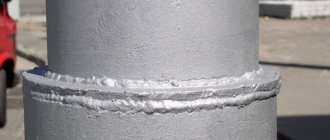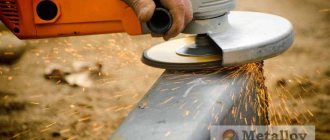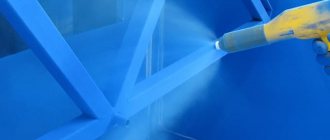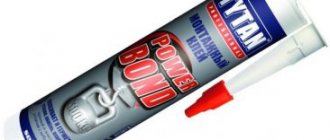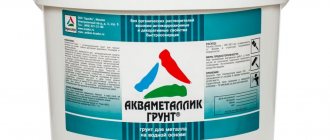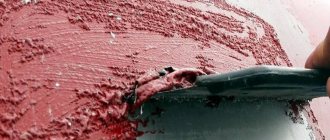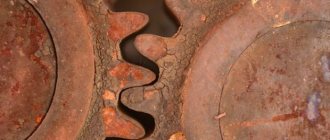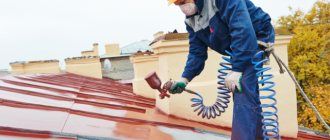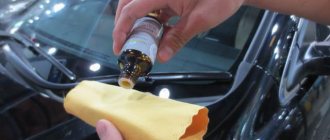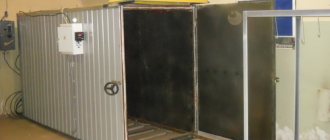How to age metal - Useful tips - 2021
Today, metal parts and surfaces are in great demand in interior design.
They decorate furniture and accessories. Aged metal is in demand: with a rough surface and its different color shades. Such decorative details give the interior or clothing items a certain time-tested solidity.
Aging process
Aging as a heat treatment is used as a final operation. Applicable to those metals and alloys in which a saturated solid solution can release an excess component and spontaneously decompose.
After the aging procedure, the metal's hardness and strength increase, but its viscosity and ductility decrease, but these values remain the same throughout its service life.
Aging of steel is carried out to change the internal structure after hardening. The resulting ferrite solid solution, saturated with carbon and nitrogen, disintegrates when heated. Depending on the amount of carbon content in the alloy, the internal structure can take the form:
- disc-shaped (in the form of thin plates),
- spherical,
- cubic,
- needle-shaped
Artificial aging of metal (heat treatment) is applied to those alloys in which the solubility of one element in the solid state is significantly reduced. This occurs when the temperature drops.
During artificial aging in steels with low carbon content, not higher than 0.05%, the saturated solid alpha solution decomposes. In this case, excess phases are released. This metamorphosis leads to a decrease in ductility, but leads to an increase in hardness and strength.
The figure shows the Orowan model, which illustrates the movement of dislocations. The maximum effect can be achieved with natural aging, but the time spent on this will be significant. The speed of the process can be increased by artificial aging, but the strength characteristics will be reduced.
Hardness depending on aging time
The graph clearly shows that reducing the aging time does not allow obtaining high hardness.
The course of the aging process largely depends on carbon and nitrogen. This is especially noticeable in low-carbon steels. As the temperature decreases, nitrogen becomes less soluble in alpha iron.
For example, at a temperature of 590°C, dissolved nitrogen contains 0.1%, but already at 20°C its content decreases to 0.004%. When aging, the alpha solution releases nitrides.
Therefore, the effect of nitrogen is less pronounced compared to the same carbon under temperature influence.
With an increase in carbon in steels, the effect of changing the structure obtained during thermal exposure increases. The maximum volume of carbon that can be dissolved in alpha iron is 0.02-0.04%. With this content, a hardened product subjected to natural aging has a hardness one and a half times higher than after annealing.
Aging is the main way to increase the strength of heat-resistant alloys (with a high nickel content). This group also includes alloys based on aluminum, copper, and magnesium. In addition, the modified structure of the above metals and alloys gives them coercive force.
Aluminum and aluminium-copper alloys are subject to destruction at different temperatures (over 100°C) due to differences in the temperature of decomposition of the structure of different metals. This is how low-temperature and high-temperature changes in structure are distinguished.
The decomposition of the solid solution occurs in two ways. In the first case, the formation and growth of phase particles occurs throughout the entire volume. In the second case, the decay is discontinuous (cellular). During it, cells grow in colonies. Colonies have a cellular structure, and growth proceeds from the grain boundary and moves inward, decreasing in size.
Metal aging technology
- Before starting work, the metal must be cleaned of any contaminants. The success of the work depends on the preliminary preparation, so it is necessary to clean the surface diligently. Sometimes it is even recommended to anneal the metal to remove residual resins or other substances.
- If the parts are made of copper or brass, then it must first be bleached with a weak solution of sulfuric acid. And iron is treated with a more concentrated solution of sulfuric acid. Aluminum products are treated with bicarbonate of soda. Regardless of the processing method, after completion of work, the parts must be thoroughly rinsed under running water and cleaned with a stiff brush.
- Nitric acid is used to work with brass and copper.
Since the fumes of this acid are harmful to humans, special care should be taken, and in general it is not recommended to work with this substance indoors. It is better to go outside to work with metal. - The acid is applied to the surface of the metal product with a cotton swab wound on a wooden stick.
The reaction to the substance will be noticeable immediately - the surface of the metal will change color from rich green to black. After the reaction has occurred, the metal must be heated until the composition completely evaporates. Then the product is washed under running hot running water. - The color of the finished product can range from olive green to brown and from light gray to black. This depends on the concentration of the acid, the duration of contact with it, and the degree of heating. The resulting effect is quite durable, so you can polish or grind the part.
- If iron parts are aged, they are thoroughly cleaned, coated with drying oil, and then heated to 300-400 degrees Celsius. For uniform surface treatment, it is better to heat the part in an oven. If a light tone of the part is required, then nitric acid is used.
- To process aluminum products I use kerosene or soot. These substances emphasize the structure of this metal and give it a beautiful decorative appearance.
Method for rapid aging of metal products
Often, for various creative ideas, antique buttons, needles, pins, nails, horseshoes, etc. are needed. You can quickly age such metal products using vinegar (1/4 cup) and salt (2 tablespoons).
- Mix both substances and immerse the metal part in the resulting solution.
- The composition is mixed, covered with a lid with holes and left for 12 hours.
- Then the parts are taken out and dried on newspaper.
- If excess rust has formed, you can sand it off with sandpaper.
To work with the solution, it is better to take glass or plastic containers that are resistant to chemicals. Mix the ingredients with a wooden, plastic or porcelain spoon. A container of larger volume is required, since after immersing a metal part in the solution, the liquid will begin to foam.
If work is not carried out outdoors, a well-ventilated area should be used.
To age metal you will need:
✔ bicarbonate of soda or active acids,
Sequence of work
— There are currently many methods of metalworking and decorative design of metals, which is facilitated by the development of the chemical industry. Many methods of aging metal have come to us from the distant past. Therefore, the method of decorative metal processing must be chosen depending on the desired result and the type of metal used.
— Before starting work, it is necessary to clean the surface of the material from all kinds of contaminants. The results of labor are largely determined by the quality of this stage. It is possible to carefully anneal the product, which will rid it of any remaining resin or other impurities.
Copper and brass alloys should be bleached in advance in a solution of low concentration sulfuric acid; in this case, it is recommended to use sulfuric acid for iron, and bicarbonate of soda for aluminum products.
After treatment, all items must be thoroughly rinsed and cleaned with a metal bristle brush. Only after this can you begin the finishing itself.
— Nitric acid will help to age brass and copper. The main thing is to take precautions (all work should be done outdoors), since this acid emits dangerous fumes.
A cotton swab must be wrapped around a wooden stick. This device treats the metal surface with nitric acid or its solution.
Then (after the reaction is completed), the object should be heated until the evaporation reaction stops.
— Acid concentration, metal processing time and the degree of subsequent heating are the main factors that determine the future color of the surface.
— If the choice is made in favor of iron products, then they must be treated with drying oil immediately after cleaning. Then the object is heated to 300-450C. A more uniform surface will be obtained by using an oven. Lighter surface tones can be obtained using nitric acid.
— To decorate or age an aluminum surface, you should use soot or kerosene. These substances will maximally emphasize all the features in the relief and give the surface uniqueness.
Thermal aging
The metal strengthening phase during thermal exposure occurs at the maximum point. There is a metastable solution gap in the Guinier-Preston zone here. This type of hardening of metals and alloys is usually called dispersion hardening.
Dependence of strength on time and aging temperature
With longer aging, overaging begins, that is, a decrease in strength characteristics. This is influenced by:
Types of thermal aging of metal:
- Two-stage - hardening, then holding at substitution temperature, and then holding at an elevated temperature to obtain uniformity of the solid solution.
- Hardening – hardening and one holding phase with natural cooling.
- Natural – for aluminum alloys.
- Artificial - for alloys of non-ferrous metals heated to a temperature higher than that used for natural destruction.
- Stabilization – high aging temperatures and long exposure times help maintain the dimensions and properties of the part.
Mechanical aging of metal
The destruction of steel with the help of deforming forces occurs in the temperature range below the recrystallization process. This is due to the formation and movement of dislocations. During cold plastic deformation, the density of dislocations increases, which further increases with increasing loads.
The changing mechanical properties of the metal causes the movement of carbon and nitrogen atoms towards dislocations, which are located in the alpha solution. Having reached dislocations, atoms form clouds (Cottrell atmospheres). These accumulations prevent the movement of dislocations, resulting in a change in properties. The inherent properties of parts aged by heat treatment appear.
If the effect of aging by deformation is strongly influenced by nitrogen, nickel and copper, then with the addition of vanadium, titanium and niobium this effect completely disappears. Therefore, it is recommended to use steel with an aluminum content of 0.02-0.07%.
Recommended regimens for aging
- for steels with high carbon content: temperature about 130°C-150°C, holding time about 25-30 hours,
- for alloys made of non-ferrous metals: temperature about 250°C, holding time about 1 hour.
- for a natural process: temperature about 20°C,
- for an artificial process: temperature about 250°C, holding time about 1 hour.
The heating temperature and holding time are selected individually for each grade of metal and alloy, depending on their composition.
, please select a piece of text and press Ctrl+Enter.
Watch the video: Blackening metal with a BOW. BlackingBroom metal. (January 2020)
Mechanical and thermal aging
There are two types of metal aging: thermal and mechanical. Let's look at each of them in more detail.
Thermal aging
The metal strengthening phase during thermal exposure occurs at the maximum point. There is a metastable solution gap in the Guinier-Preston zone here. This type of hardening of metals and alloys is usually called dispersion hardening.
Dependence of strength on time and aging temperature
With longer aging, overaging begins, that is, a decrease in strength characteristics. This is influenced by:
- coagulation;
- partial replacement of particles with incoherent ones.
Types of thermal aging of metal:
- Two-stage - hardening, then holding at substitution temperature, and then holding at an elevated temperature to obtain uniformity of the solid solution.
- Hardening – hardening and one holding phase with natural cooling.
- Natural – for aluminum alloys.
- Artificial - for alloys of non-ferrous metals heated to a temperature higher than that used for natural destruction.
- Stabilization – high aging temperatures and long exposure times help maintain the dimensions and properties of the part.
Mechanical aging of metal
The destruction of steel with the help of deforming forces occurs in the temperature range below the recrystallization process. This is due to the formation and movement of dislocations. During cold plastic deformation, the density of dislocations increases, which further increases with increasing loads.
The changing mechanical properties of the metal causes the movement of carbon and nitrogen atoms towards dislocations, which are located in the alpha solution. Having reached dislocations, atoms form clouds (Cottrell atmospheres). These accumulations prevent the movement of dislocations, resulting in a change in properties. The inherent properties of parts aged by heat treatment appear.
If the effect of aging by deformation is strongly influenced by nitrogen, nickel and copper, then with the addition of vanadium, titanium and niobium this effect completely disappears. Therefore, it is recommended to use steel with an aluminum content of 0.02-0.07%.
Metal aging heat treatment
Metal aging is a process that occurs inside the metal and causes changes in physical and mechanical properties and internal structure. These processes can occur naturally (over a long period of time and at a temperature close to 20°C) or artificially (heat treatment and plastic deformation).
Metal aging
Mechanical and thermal aging
There are two types of metal aging: thermal and mechanical. Let's look at each of them in more detail.
Heat treatment of alloys. Types of heat treatment
Heat treatment of alloys is an integral part of the production process of ferrous and non-ferrous metallurgy. As a result of this procedure, metals are able to change their characteristics to the required values. In this article we will look at the main types of heat treatment used in modern industry.
The essence of heat treatment
During the production process, semi-finished products and metal parts are subjected to heat treatment to give them the desired properties (strength, resistance to corrosion and wear, etc.).
Heat treatment of alloys is a set of artificially created processes during which structural and physical-mechanical changes occur in alloys under the influence of high temperatures, but the chemical composition of the substance is preserved.
Purpose of heat treatment
Metal products that are used daily in any sector of the national economy must meet high wear resistance requirements. Metal, as a raw material, needs to enhance the necessary performance properties, which can be achieved by exposing it to high temperatures.
Thermal treatment of alloys at high temperatures changes the original structure of the substance, redistributes its constituent components, and transforms the size and shape of the crystals. All this leads to minimizing the internal stress of the metal and thus increases its physical and mechanical properties.
Types of heat treatment
Heat treatment of metal alloys comes down to three simple processes: heating the raw material (semi-finished product) to the required temperature, maintaining it in the specified conditions for the required time and rapid cooling. In modern production, several types of heat treatment are used, differing in some technological features, but the process algorithm generally remains the same everywhere.
Depending on the method of implementation, heat treatment can be of the following types:
- Thermal (hardening, tempering, annealing, aging, cryogenic treatment).
- Thermo-mechanical involves processing at high temperatures in combination with mechanical stress on the alloy.
- Chemical-thermal involves heat treatment of metal with subsequent enrichment of the surface of the product with chemical elements (carbon, nitrogen, chromium, etc.).
Annealing
Annealing is a production process in which metals and alloys are heated to a given temperature, and then, together with the furnace in which the procedure took place, they cool very slowly naturally.
As a result of annealing, it is possible to eliminate inhomogeneities in the chemical composition of the substance, relieve internal stress, achieve a grain structure and improve it as such, as well as reduce the hardness of the alloy to facilitate its further processing.
There are two types of annealing: annealing of the first and second kind.
Annealing of the first kind involves heat treatment, as a result of which changes in the phase state of the alloy are insignificant or absent altogether.
It also has its own varieties: homogenized - the annealing temperature is 1100-1200, under such conditions the alloys are kept for 8-15 hours, recrystallization (at t 100-200) annealing is used for riveted steel, that is, deformed when it is already cold.
Second-order annealing leads to significant phase changes in the alloy. It also has several varieties:
- Full annealing is heating the alloy 30-50 above the critical temperature characteristic of a given substance and cooling at a specified rate (200 / hour - carbon steels, 100 / hour and 50 / hour - low-alloy and high-alloy steels, respectively).
- Incomplete - heating to a critical point and slow cooling.
- Diffusion – annealing temperature 1100-1200.
- Isothermal - heating occurs in the same way as with full annealing, but after this it is rapidly cooled to a temperature slightly below critical and left to cool in air.
- Normalized - complete annealing followed by cooling of the metal in air rather than in a furnace.
Hardening
Hardening is a manipulation with an alloy, the purpose of which is to achieve a martensitic transformation of the metal, which reduces the ductility of the product and increases its strength.
Hardening, as well as annealing, involves heating the metal in a furnace above a critical temperature to the hardening temperature; the difference is a higher cooling rate, which occurs in a bath of liquid.
Depending on the metal and even its shape, different types of hardening are used:
- Quenching in one environment, that is, in one bath with liquid (water for large parts, oil for small parts).
- Intermittent quenching - cooling takes place in two successive stages: first in a liquid (a sharper coolant) to a temperature of approximately 300, then in air or in another bath of oil.
- Stepped - when the product reaches the hardening temperature, it is cooled for some time in molten salts, followed by cooling in air.
- Isothermal - the technology is very similar to step hardening, differing only in the exposure time of the product at the martensitic transformation temperature.
- Quenching with self-tempering differs from other types in that the heated metal is not completely cooled, leaving a warm area in the middle of the part. As a result of this manipulation, the product acquires properties of increased strength on the surface and high viscosity in the middle. This combination is extremely necessary for percussion instruments (hammers, chisels, etc.)
Vacation
Tempering is the final stage of heat treatment of alloys, determining the final structure of the metal. The main purpose of tempering is to reduce the fragility of the metal product.
The principle is to heat the part to a temperature below critical and cool it.
Since heat treatment modes and cooling rates of metal products for various purposes may differ, there are three types of tempering:
- High - heating temperature from 350-600 to a value below critical. This procedure is most often used for metal structures.
- Medium – heat treatment at t 350-500, common for spring products and leaf springs.
- Low - the heating temperature of the product is not higher than 250, which allows you to achieve high strength and wear resistance of parts.
Aging
Aging is a heat treatment of alloys that causes the decomposition of supersaturated metal after hardening. The result of aging is an increase in the limits of hardness, fluidity and strength of the finished product. Not only cast iron, but also non-ferrous metals, including easily deformable aluminum alloys, undergo aging.
If a metal product subjected to hardening is kept at normal temperature, processes occur in it that lead to a spontaneous increase in strength and a decrease in ductility. This is called natural aging of metal.
If the same manipulation is performed under conditions of elevated temperature, it will be called artificial aging.
Cryogenic treatment
Changes in the structure of alloys, and therefore their properties, can be achieved not only at high, but also at extremely low temperatures. The heat treatment of alloys at temperatures below zero is called cryogenic.
This technology is widely used in a variety of sectors of the national economy as a complement to high-temperature heat treatments, since it can significantly reduce the costs of thermal hardening of products.
Cryogenic processing of alloys is carried out at t -196 in a special cryogenic processor. This technology can significantly increase the service life of the treated part and anti-corrosion properties, as well as eliminate the need for repeated treatments.
Thermo-mechanical treatment
A new method of processing alloys combines the processing of metals at high temperatures with mechanical deformation of products in a plastic state. Thermomechanical treatment (TMT) can be of three types according to the method of implementation:
- Low-temperature TMT consists of two stages: plastic deformation followed by hardening and tempering of the part. The main difference from other types of TMT is the heating temperature to the austenitic state of the alloy.
- High-temperature TMT involves heating the alloy to a martensitic state in combination with plastic deformation.
- Preliminary - deformation is carried out at t 20 followed by hardening and tempering of the metal.
Chemical-thermal treatment
It is also possible to change the structure and properties of alloys using chemical-thermal treatment, which combines thermal and chemical effects on metals. The ultimate goal of this procedure, in addition to imparting increased strength, hardness, and wear resistance to the product, is also to give the part acid resistance and fire resistance. This group includes the following types of heat treatment:
- Cementation is carried out to give the surface of the product additional strength. The essence of the procedure is to saturate the metal with carbon. Cementation can be performed in two ways: solid and gas carburization. In the first case, the material being processed, together with coal and its activator, is placed in a furnace and heated to a certain temperature, followed by keeping it in this environment and cooling. In the case of gas carburization, the product is heated in a furnace to 900 under a continuous stream of carbon-containing gas.
- Nitriding is a chemical-thermal treatment of metal products by saturating their surface in nitrogen environments. The result of this procedure is an increase in the tensile strength of the part and an increase in its corrosion resistance.
- Cyanidation is the saturation of a metal with both nitrogen and carbon. The medium can be liquid (molten carbon- and nitrogen-containing salts) and gaseous.
- Diffusion metallization is a modern method of imparting heat resistance, acid resistance and wear resistance to metal products. The surface of such alloys is saturated with various metals (aluminum, chromium) and metalloids (silicon, boron).
Features of heat treatment of cast iron
Cast iron alloys are subjected to heat treatment using a slightly different technology than non-ferrous metal alloys.
Cast iron (gray, high-strength, alloyed) undergoes the following types of heat treatment: annealing (at t 500-650), normalization, hardening (continuous, isothermal, surface), tempering, nitriding (gray cast iron), aluminizing (pearlitic cast iron), chrome plating.
As a result, all these procedures significantly improve the properties of the final cast iron products: they increase the service life, eliminate the possibility of cracks during use of the product, and increase the strength and heat resistance of cast iron.
Heat treatment of non-ferrous alloys
Non-ferrous metals and alloys have different properties and therefore are processed using different methods. Thus, copper alloys undergo recrystallization annealing to equalize the chemical composition.
For brass, low-temperature annealing technology (200-300 °C) is provided, since this alloy is prone to spontaneous cracking in a humid environment. Bronze is subjected to homogenization and annealing at temperatures up to 550.
Magnesium is annealed, hardened and subjected to artificial aging (natural aging does not occur for hardened magnesium).
Aluminum, like magnesium, is subjected to three heat treatment methods: annealing, hardening and aging, after which wrought aluminum alloys significantly increase their strength. The processing of titanium alloys includes: recrystallization annealing, hardening, aging, nitriding and carburization.
Summary
Heat treatment of metals and alloys is the main technological process in both ferrous and non-ferrous metallurgy. Modern technologies have a variety of heat treatment methods that make it possible to achieve the desired properties of each type of processed alloys.
Each metal has its own critical temperature, which means that heat treatment must be carried out taking into account the structural and physicochemical characteristics of the substance.
Ultimately, this will allow not only to achieve the desired results, but also to significantly streamline production processes.
Metal aging
Metal aging is a process that occurs inside the metal and causes changes in physical and mechanical properties and internal structure. These processes can occur naturally (over a long period of time and at a temperature close to 20°C) or artificially (heat treatment and plastic deformation).
Metal aging
Equipment and features of heat treatment of metals
Metal processing is a set of sequential measures for heating, holding and cooling metal products with strict adherence to selected modes to achieve the planned physical, chemical and mechanical properties of the material. Heating of the metal is carried out in special thermal furnaces and makes it possible to prepare the material for the subsequent restructuring of its atomic lattice. When heat treating tool steel grades, special quenching tanks are used.
It is important to understand that heat treatment of metal can act not only as a full-fledged technological process for producing a finished product with given characteristics, but also as an intermediate procedure for obtaining workpieces with special properties that improve the machinability of the material by cutting or pressure.
Heat treatment stages
A simplified algorithm for heat treatment of metal products includes three successive processes:
- heating the metal at a given speed to the desired temperature;
- keeping the metal in a heated state for a certain period of time;
- cooling the metal product to room temperature at a given speed.
Cooling procedures can be implemented using a furnace thermostat, air, containers with water (oil) or combined cooling.
A detailed examination of the types of heat treatment of alloys and metals can highlight:
- annealing
is a heat treatment that, depending on the selected mode, allows you to remove residual stress, reduce the hardness and increase the ductility of the metal, and level out the physical or chemical heterogeneity of the material; - normalization
- allows you to eliminate internal stresses and hardening, obtain a homogeneous and even fine-grained structure of the metal and prepare it for final heat treatment. During normalization, the alloy is heated above critical temperatures at which the restructuring of the crystal lattice begins and ends; - hardening
- characterized by heating above the temperatures of phase transformations, followed by accelerated cooling to give the metal increased strength and hardness; - tempering
is the final heat treatment procedure, which consists of heating the hardened metal to a temperature below the point at which the crystal lattice begins to rearrange, followed by gradual cooling in air. This allows you to eliminate accumulated internal stress, relieve the material from brittleness and give it sufficient viscosity and ductility. At the same time, the high strength, hardness and wear resistance obtained at the hardening stage are preserved; - aging
is a final heat treatment for alloys and structural materials, which can be carried out after an annealing or hardening procedure and involves accelerated cooling or reheating followed by holding and slow cooling. The result of thermal aging of a metal is an increase in its strength and a decrease in brittleness; - cold processing
- consists of temporarily placing hardened parts or workpieces in freezers or a special composition, cooled to a temperature below zero. The main advantage of cold processing is the increase in the hardness and wear resistance of the metal.
The variability of metal heat treatment makes it possible to form an optimal set of physical, mechanical and operational properties for metal products made from a wide variety of steel grades and alloys.
Thanks to correctly selected types and modes of heat treatment, it is possible to obtain a wide range of fasteners of various strength classes, wear-resistant reinforced concrete products and structures, reliable machines and equipment, durable building materials, etc.
Return to list
Natural artificial aging of metal
15.02.2018
Metal is one of the most common materials in construction and industry. Even with the advent of new high-tech composites on the market, it continues to be used as often as before.
But even such a durable and reliable material sooner or later ages, losing its original properties. The main disadvantage of metal products is that they are susceptible to corrosion.
The effect of “metal fatigue” is being widely studied today and is forcing technologists to develop new methods to neutralize it.
What is metal aging?
A process such as metal aging
, is caused by the appearance of changes in the chemical structure of the alloy, as well as physical and mechanical transformations. They lead to deterioration in the quality of parts.
The material becomes brittle, and products made from it lose their original qualities. Natural aging of metal
in nature occurs at temperatures from 20°. This is a long process that takes years.
The consequences of aging are negative, but there are also some benefits. In particular, the effect of metal aging
has a positive effect on the density of the alloy structure. Therefore, the industrial sector is actively using this. Heat-treated products last much longer and are more reliable.
Do-it-yourself artificial aging of metal – Metals, equipment, instructions
Motorists or builders will not have the desire to age metal, but craftswomen and designers now very often resort to this technique in order to obtain interesting details in interior design or decorative elements. The surface of aged metal acquires an interesting structure and various color shades - roughness and play of colors give the product solidity and originality.
Artificially aging metal is quite simple. In an elementary case, you can put it in a place with high humidity and after some time (weeks will pass) the product will be covered with a layer of rust and will look like an antique item.
The method is simple, but takes a lot of time, so at the moment, various chemicals are most often used to age metals: nitric acid, bicarbonate of soda, drying oil or active acids.
Experts are constantly finding new ways to decoratively age metal, but the most proven and accessible recipes have come to us from ancient times.
An important point in this process is the need to correctly apply chemicals to certain metals. And since we are talking about aggressive substances, when aging metals it is necessary to use personal protective equipment - gloves, goggles, respirators.
Metal aging technology
- Before starting work, the metal must be cleaned of any contaminants. The success of the work depends on the preliminary preparation, so it is necessary to clean the surface diligently. Sometimes it is even recommended to anneal the metal to remove residual resins or other substances.
- If the parts are made of copper or brass, then it must first be bleached with a weak solution of sulfuric acid. And iron is treated with a more concentrated solution of sulfuric acid. Aluminum products are treated with bicarbonate of soda. Regardless of the processing method, after completion of work, the parts must be thoroughly rinsed under running water and cleaned with a stiff brush.
- Nitric acid is used to work with brass and copper. Since the fumes of this acid are harmful to humans, special care should be taken, and in general it is not recommended to work with this substance indoors. It is better to go outside to work with metal.
- The acid is applied to the surface of the metal product with a cotton swab wound on a wooden stick. The reaction to the substance will be noticeable immediately - the surface of the metal will change color from rich green to black. After the reaction has occurred, the metal must be heated until the composition completely evaporates. Then the product is washed under running hot running water.
- The color of the finished product can range from olive green to brown and from light gray to black. This depends on the concentration of the acid, the duration of contact with it, and the degree of heating. The resulting effect is quite durable, so you can polish or grind the part.
- If iron parts are aged, they are thoroughly cleaned, coated with drying oil, and then heated to 300-400 degrees Celsius. For uniform surface treatment, it is better to heat the part in an oven. If a light tone of the part is required, then nitric acid is used.
- To process aluminum products I use kerosene or soot. These substances emphasize the structure of this metal and give it a beautiful decorative appearance.
Method for rapid aging of metal products
Often, for various creative ideas, antique buttons, needles, pins, nails, horseshoes, etc. are needed. You can quickly age such metal products using vinegar (1/4 cup) and salt (2 tablespoons).
- Mix both substances and immerse the metal part in the resulting solution.
- The composition is mixed, covered with a lid with holes and left for 12 hours.
- Then the parts are taken out and dried on newspaper.
- If excess rust has formed, you can sand it off with sandpaper.
Adviсe
To work with the solution, it is better to take glass or plastic containers that are resistant to chemicals. Mix the ingredients with a wooden, plastic or porcelain spoon.
A container of larger volume is required, since after immersing a metal part in the solution, the liquid will begin to foam.
If work is not carried out outdoors, a well-ventilated area should be used.
Evaluate the manufacturing method:
